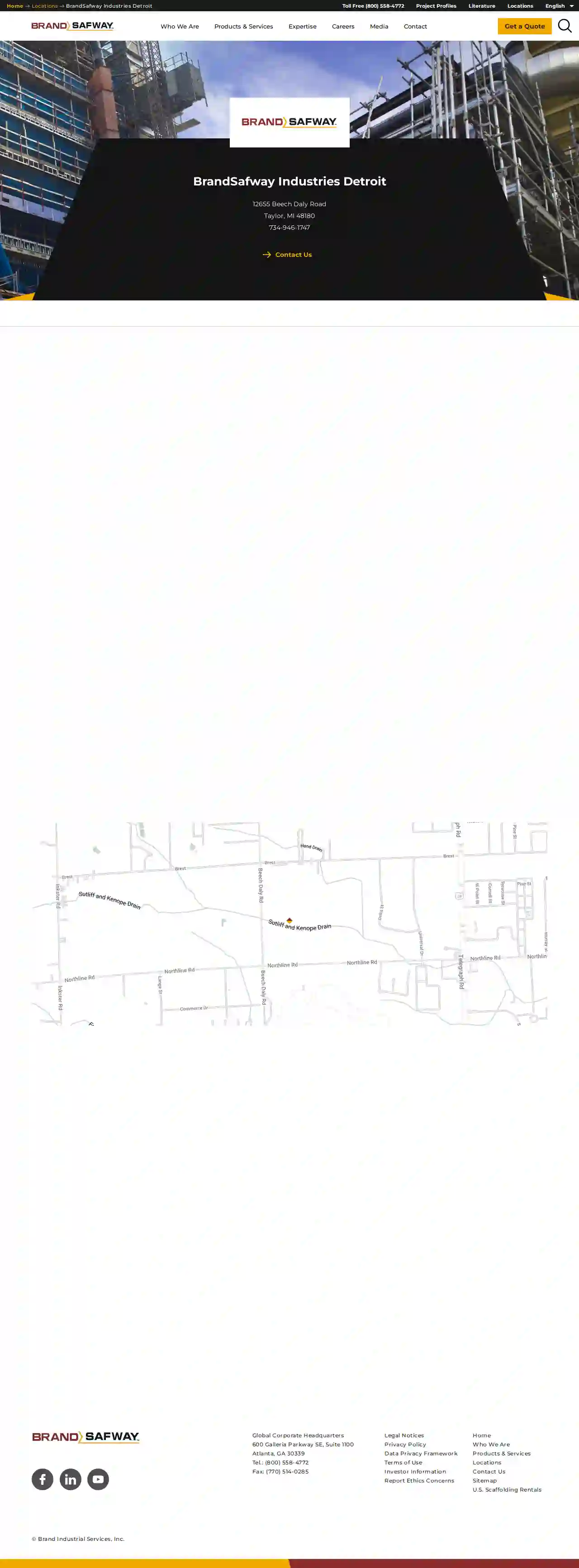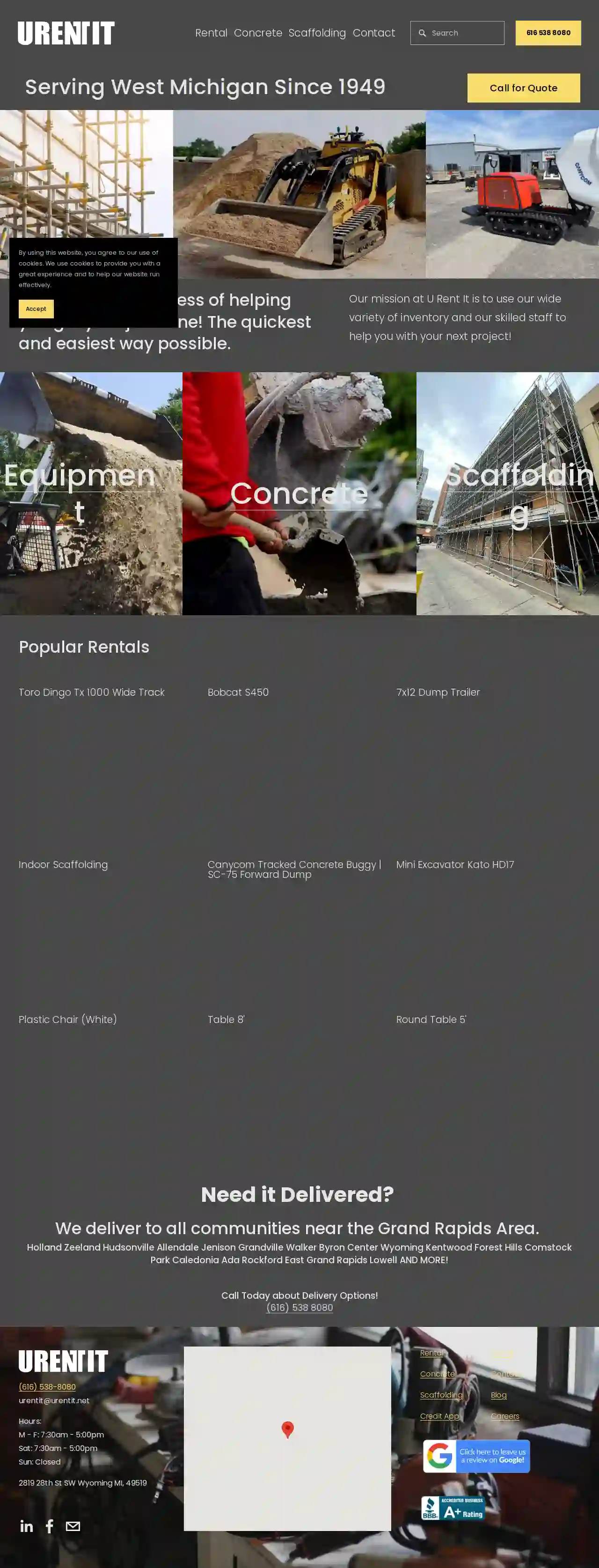Scaffolding Companies Plymouth
Best Scaffolding Company in Plymouth
Receive 3 FREE Scaffolding Specialists quotes for your project today! Compare profiles, reviews, accreditations, portfolio, etc... and choose the best deal.

Swing-Lo Suspended Scaffold Co
46 reviewsP.O. Box 1287, 75609 CR 376, Covert, MI, 49043, USFaster, safer & more economical. Swing-Lo Suspended Scaffold is a one-stop destination for your suspended scaffolding. A company where safety is paramount, we pride ourselves on our over fifty-five-year history of supplying safe and durable suspended scaffolding worldwide. Our approach: The invention and introduction of Swing-Lo Suspended Scaffolds stemmed from the old adage, "necessity is the mother of invention". That was the motivation behind the invention of Swing-Lo Suspended Scaffolds by H. George Leonard, a painting contractor whose bid was below his competitors. The idea was derived from the old ice tong and a pair of scissors. The combination of both items provided him with a model that would scissor and grip the bottom flanges of I-beams on bridges. This model, along with a connecting hanger component produced a simple suspended scaffold that could be easily erected and dismantled. The application and performance of this scaffold was well received, and soon became a demand by bridge and painting contractors. Thus, the painter became the manufacturer of a particular type of scaffold whose market has expanded from local to national to international. Constant improvements in the design and fabrication of Swing-Lo Suspended Scaffolds have served to provide a safer, more efficient and economical scaffolding system for highway and utility contractors when access to work areas are a problem. Swing-Lo Suspended Scaffolds are patented with built-in, quick locking devices and fasteners for instant assembly. They have lessened the risks to the worker, lowered the cost, and increased safety in modern bridge and power plant construction and maintenance.
- Services
- Why Us?
- Accreditations
- Gallery
Get Quote
BrandSafway Industries Detroit
3.25 reviews123 Main St, Detroit, 48201, USBrandSafway is a leading provider of access and scaffolding solutions in Detroit, Michigan. With a strong commitment to safety and customer satisfaction, we offer a wide range of services to support various industries, including construction, energy, and manufacturing. Our team of experts is dedicated to delivering high-quality solutions that meet the unique needs of each project. From scaffolding and hoisting to shoring and forming, we have the expertise and equipment to ensure your project is completed safely and efficiently.
- Services
- Why Us?
- Accreditations
- Our Team
- Testimonials
Get Quote
Fraco USA, Inc.
51 reviews91, chemin des Patriotes, St-Mathias-sur-Richelieu, J3L 1T5, USFraco is a company committed to providing innovative and state-of-the-art vertical transportation equipment and solutions for the construction industry. With over 30 years of experience, we have been anticipating the access system needs of the construction industry. Our custom solutions ensure the safety and productivity of workers on construction sites around the world. We offer a range of products, including elevators, construction hoists, transport platforms, and permanent industrial elevators, as well as associated products and accessories.
- Services
- Why Us?
- Accreditations
- Gallery
Get Quote
National Ladder & Scaffold Co
4.539 reviews1234 Industrial Drive, Kentwood, 49512, USNational Ladder & Scaffold Co. is a leading provider of ladder and scaffolding solutions, offering a wide range of products and services to meet the needs of various industries. With a strong commitment to safety, quality, and customer satisfaction, the company strives to provide innovative solutions that enhance productivity and efficiency. Their team of experienced professionals ensures that clients receive top-notch service and support.
- Services
- Why Us?
- Accreditations
- Our Team
- Testimonials
Get Quote
U Rent It / Scaffolding Systems Inc.
4.981 reviews2819 28th St. SW, Wyoming, MI, 49519, USU Rent It is a leading equipment rental company in West Michigan, dedicated to providing a wide variety of inventory and skilled staff to help with your next project. With a mission to make your job easier and quicker, U Rent It offers equipment rentals including concrete, scaffolding, and popular items like indoor scaffolding, air compressors, and excavators. They also provide delivery options to all communities near the Grand Rapids Area. U Rent It is committed to customer satisfaction and offers a credit application for those interested.
- Services
- Why Us?
- Accreditations
- Our Team
- Testimonials
- Gallery
Get Quote
Scaffolding Systems Inc
2819 28th St. SW, Wyoming, MI, 49519, USU Rent It is a family-owned business that has been serving West Michigan since 1949. Our mission is to provide a wide variety of inventory and skilled staff to help you with your next project. We offer equipment rentals for concrete, scaffolding, and more, with delivery options available to all communities near the Grand Rapids Area.
- Services
- Why Us?
- Gallery
Get Quote- A-
A-1 Rental Inc
4.3153 reviewsDetroit, US- Services
- Why Us?
Get Quote - To
Tool & Truck Rental at The Home Depot
3.414 reviewsKalamazoo, US- Services
- Why Us?
Get Quote - Mi
Miller Davis Company
3.712 reviewsKalamazoo, US- Services
- Why Us?
Get Quote - Na
National Ladder & Scaffold Co
4.3100 reviewsDetroit, US- Services
- Why Us?
Get Quote
Over 2,353+ Scaffolding Companies in our network
Our scaffolding contractors operate in Plymouth & surroundings!
ScaffoldingHQ has curated and vetted Top Scaffolding Businesses in and around Plymouth. Find a reliable pro today.
Frequently Asked Questions About Scaffolding Companies
- Workers: Consider the number of workers on the scaffolding at any given time.
- Materials: Include the weight of building materials, tools, and equipment being used on the platform.
- Environmental Factors: Factor in potential loads from wind or snow, especially for taller scaffolding structures.
- Online Directories: Use specialized directories like ScaffoldingHQ to search for scaffolding companies in your area.
- Search Engines: Use Google or other search engines to search for 'scaffolding companies near me' or 'scaffolding rental [your location]'.
- Local Construction Associations: Contact local construction associations for recommendations.
- Word-of-Mouth Referrals: Ask friends, family, or colleagues for recommendations based on their past experiences.
- Project Height and Access: The height of the structure and the accessibility of the working area are primary considerations.
- Load Capacity: The weight of workers, materials, and equipment that the scaffolding needs to support.
- Project Complexity and Shape: The shape and complexity of the structure may necessitate specialized scaffolding configurations.
- Ground Conditions: The type of ground (soft, uneven, sloping) will influence the scaffolding foundation and support requirements.
- Duration of Use: The length of time the scaffolding will be needed can impact the choice of system.
- Budget: Different scaffolding types have varying costs.
- A temporary structure with a larger platform for workers and materials.
- Offers greater stability and working space.
- Suitable for tasks requiring movement and multiple workers.
- Used for higher elevations and more complex projects.
- Used for reaching specific points at height for short durations.
- Less stable than scaffolding, requiring more caution and balance.
- Not suitable for tasks involving heavy materials or extended work periods.
What is the weight limit for scaffolding?
How can I find scaffolding companies near me?
How do I choose the right type of scaffolding for my project?
What is the difference between a scaffold and a ladder?
Scaffolding:
What is the weight limit for scaffolding?
- Workers: Consider the number of workers on the scaffolding at any given time.
- Materials: Include the weight of building materials, tools, and equipment being used on the platform.
- Environmental Factors: Factor in potential loads from wind or snow, especially for taller scaffolding structures.
How can I find scaffolding companies near me?
- Online Directories: Use specialized directories like ScaffoldingHQ to search for scaffolding companies in your area.
- Search Engines: Use Google or other search engines to search for 'scaffolding companies near me' or 'scaffolding rental [your location]'.
- Local Construction Associations: Contact local construction associations for recommendations.
- Word-of-Mouth Referrals: Ask friends, family, or colleagues for recommendations based on their past experiences.
How do I choose the right type of scaffolding for my project?
- Project Height and Access: The height of the structure and the accessibility of the working area are primary considerations.
- Load Capacity: The weight of workers, materials, and equipment that the scaffolding needs to support.
- Project Complexity and Shape: The shape and complexity of the structure may necessitate specialized scaffolding configurations.
- Ground Conditions: The type of ground (soft, uneven, sloping) will influence the scaffolding foundation and support requirements.
- Duration of Use: The length of time the scaffolding will be needed can impact the choice of system.
- Budget: Different scaffolding types have varying costs.
What is the difference between a scaffold and a ladder?
Scaffolding:
- A temporary structure with a larger platform for workers and materials.
- Offers greater stability and working space.
- Suitable for tasks requiring movement and multiple workers.
- Used for higher elevations and more complex projects.
- Used for reaching specific points at height for short durations.
- Less stable than scaffolding, requiring more caution and balance.
- Not suitable for tasks involving heavy materials or extended work periods.